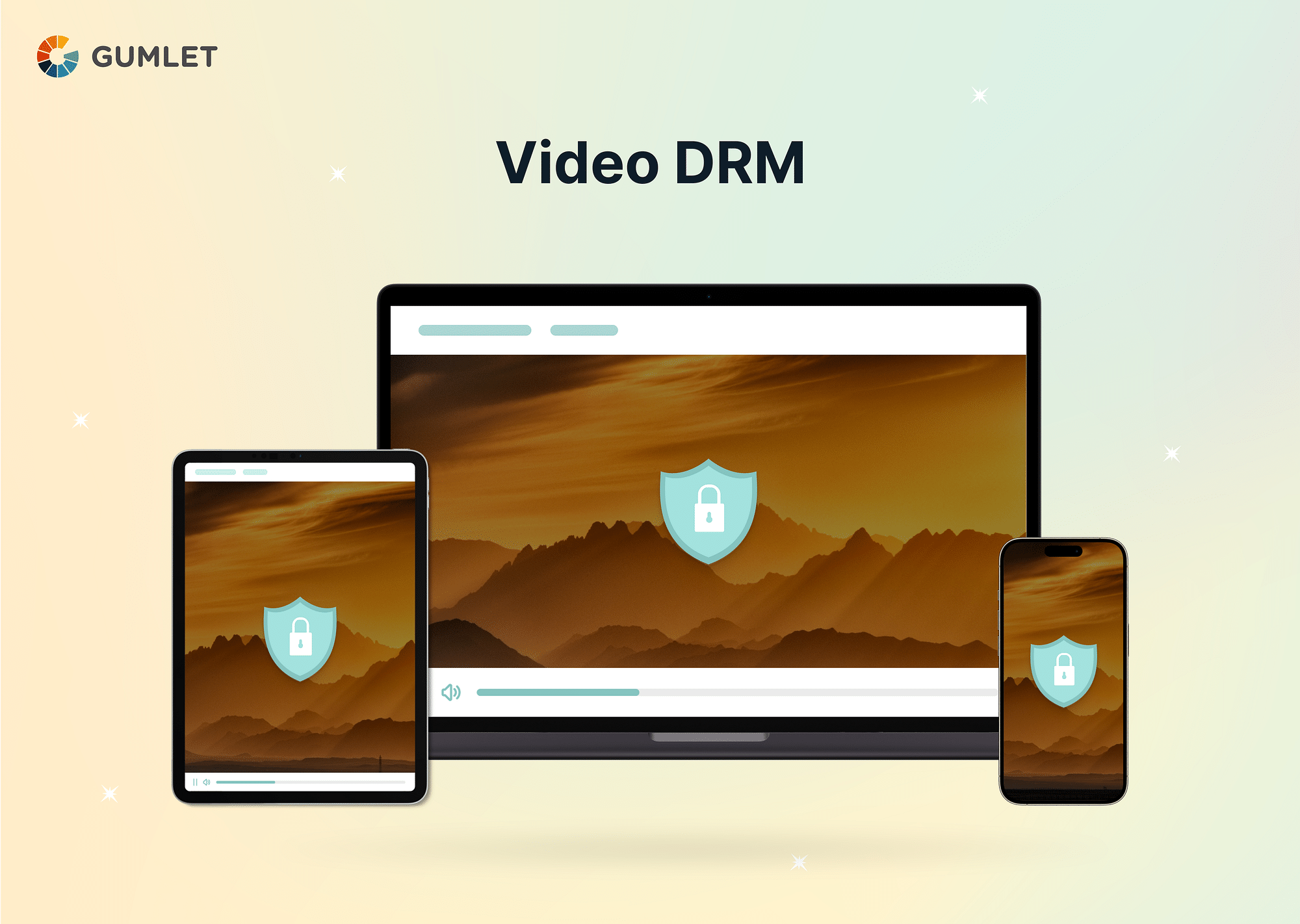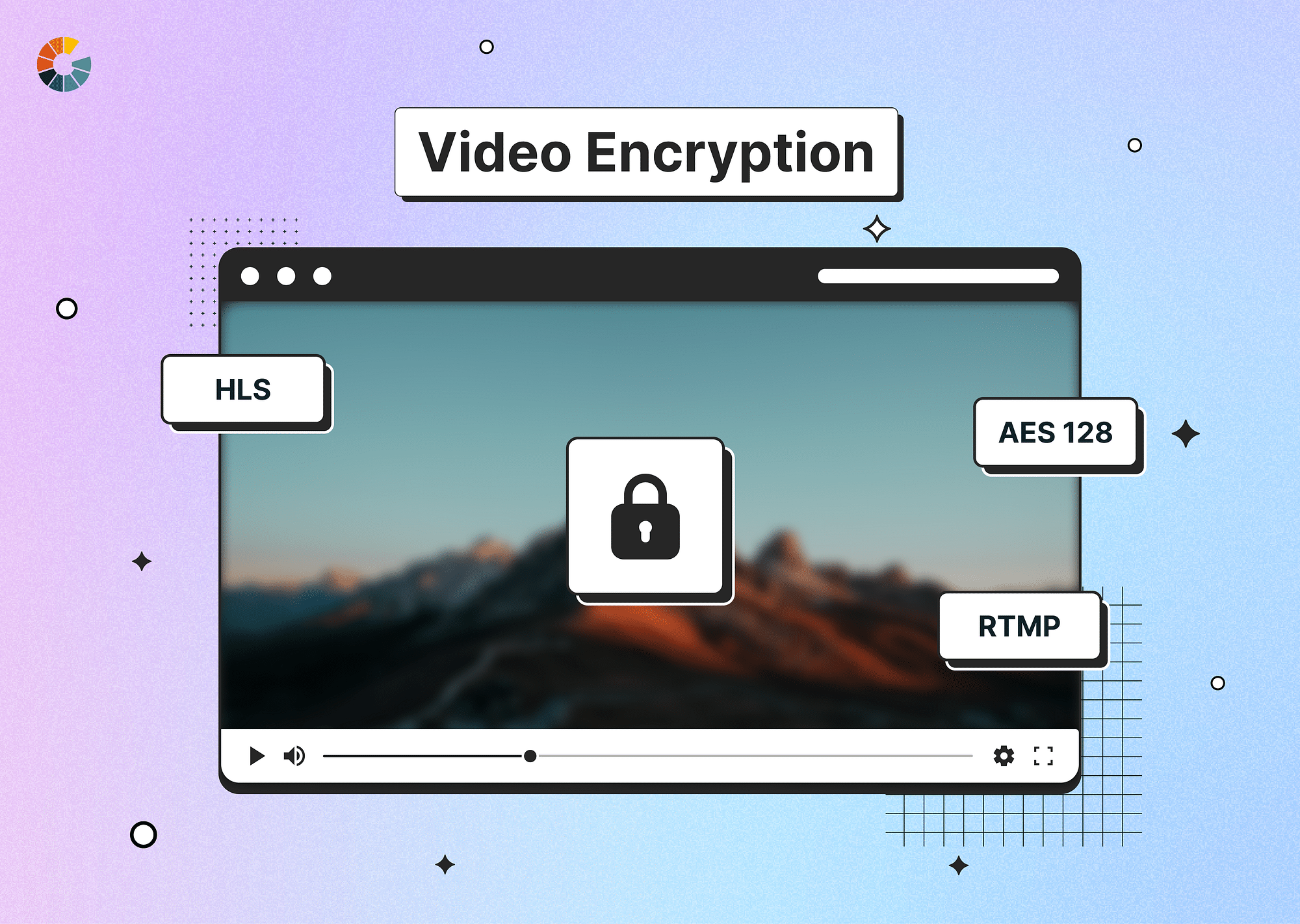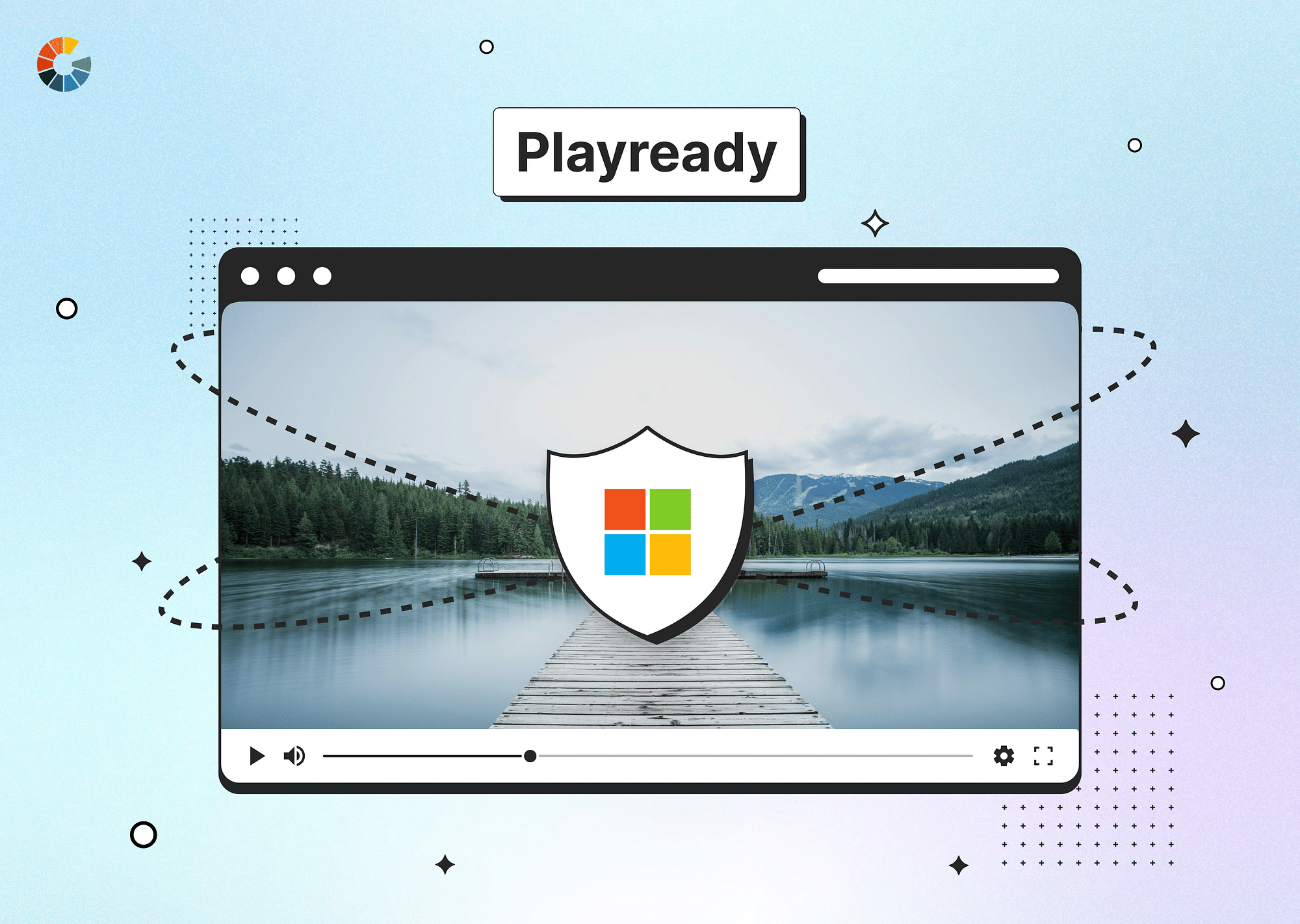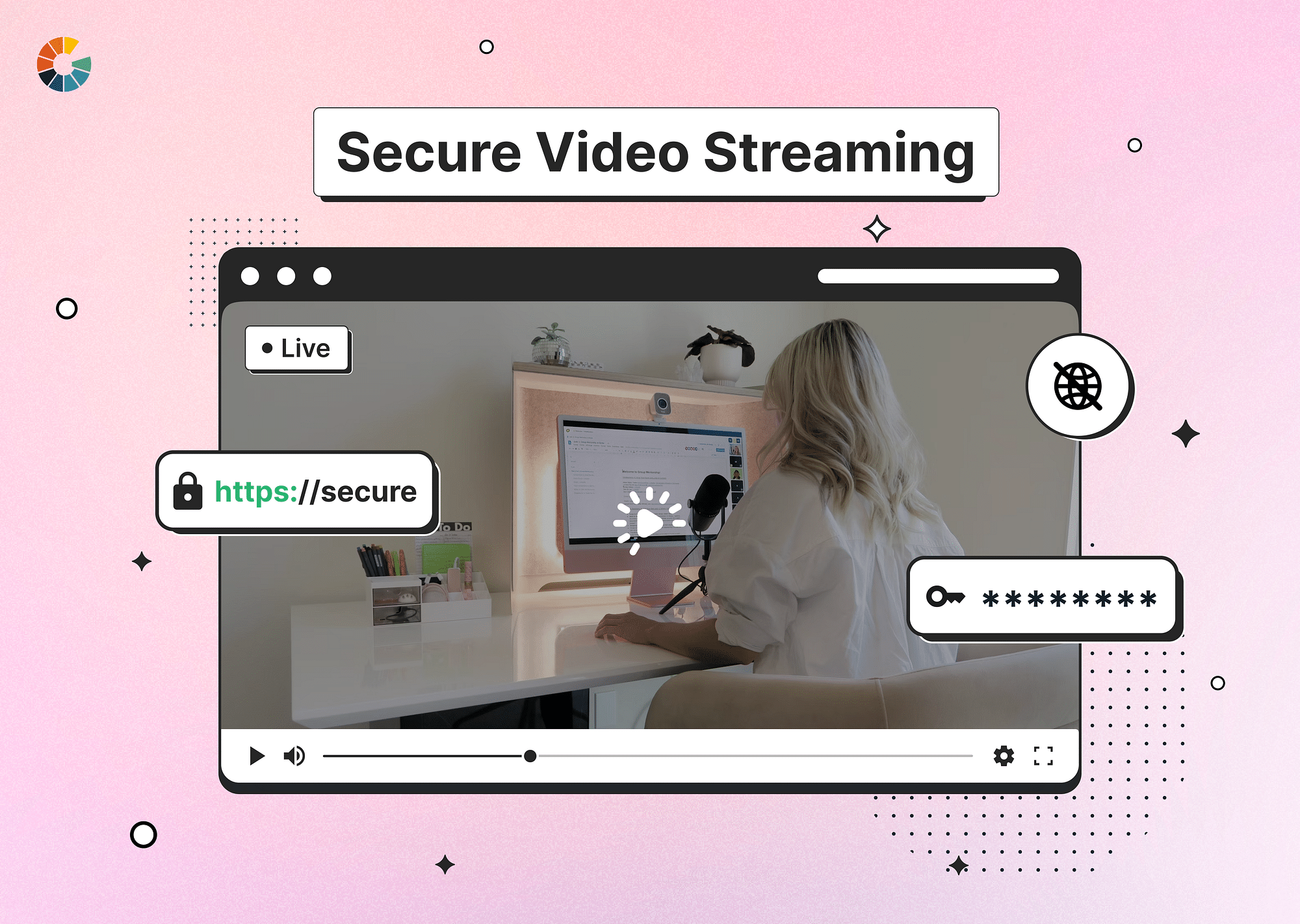What is Video DRM?
Video DRM, or Digital Rights Management, is a set of technologies and protocols that encrypt video content and control access to it. It acts like a digital padlock, ensuring only authorized users with the right key can watch your videos. This protects your valuable content from unauthorized copying, distribution, and piracy.
To put it simply, Video DRM ensures encrypted storage and transmission of video content, so it can only be accessed by authorized devices and users.
Single-click DRM encryption with Gumlet
Protect your videos with DRM starting at just $199/mo with an authorized Widevine & Fairplay DRM vendor.
What does “DRM Protected” mean?
The phrase “DRM protected content” indicates that the digital content you publish follows a set of authorization rules that dictate how it will be used and managed. It essentially refers to content that is protected by DRM solutions which prevent illicit downloads and duplications.
Depending on your requirements, Video DRM solutions can have varying levels of complexity. Leading content distributors package video content with the help of Multi-DRM solutions to ensure best-in-class security and uninterrupted device compatibility.
DRM also monitors how many times a certain video is being accessed and which devices it is being viewed on—this helps ensure systematic use of copyrighted material.
For instance, if a video player receives a playback request from a device, it will ask the user for a licensed, authorized key to determine if the device is authorized to access that particular video or platform. If the authorization process is successful, the user will receive a decryption key that will unlock the video for playback.
Why do you need DRM Protection for your Video content?
Video DRM is the lock and key that secures it in today's online world, rampant with copy and share pirates. It is a cutting-edge technology that helps prevent video piracy, unauthorized access, and illegal distribution and modification of premium content on video platforms.
Here's why DRM is a must-have for your Videos:
- Protect your investment: Imagine pouring time and resources into content, only to see it pirated and shared freely. DRM safeguards your financial return by preventing unauthorized access and revenue loss.
- Exclusive access control: Offer early access or exclusive content? DRM ensures only your chosen audience enjoys it, boosting its perceived value and attracting viewers.
- License compliance: Many content licensors demand DRM protection. Implementing it shows your commitment to content security and strengthens partnerships.
- Unlock new revenue streams: DRM empowers you to explore subscription models, rentals, or pay-per-view options, opening up exciting new possibilities.
Why is it better than other video protection methods?
DRM protection is becoming a standard practice for content creators(Individual & businesses) due to digital media's vulnerability to peer-to-peer exchanges, unauthorized distribution, and piracy.
Other video protection methods like password protection and watermarking exist, but DRM stands out for its powerful encryption and granular control. It lets you set device limitations, expiration dates, and geographic restrictions. This empowers you to explore revenue models while still reaching new audiences through the platforms it supports. DRM solutions protect copyright holders and prevent common cybersecurity risks, preventing significant business revenue loss.
How does Video DRM work?
Imagine your video content as a precious treasure chest. Video DRM, or Digital Rights Management, acts like a high-tech lock and key system, ensuring only authorized viewers can access the treasure within.
Here's how DRM works in detail:
1. Encryption: Picture your video data scrambled with a secret code. This is where encryption comes in. DRM systems use advanced encryption algorithms to transform your video into an unreadable format, like a jumbled puzzle.
2. Decryption Keys: Think of these as special access keys. Authorized viewers receive unique decryption keys that unscramble the video data back to its original form, allowing them to watch the content. These keys are typically associated with specific devices, accounts, or platforms.
3. License Servers: Imagine a central vault holding all the decryption keys. License servers act as this central repository, managing and distributing keys to authorized users when they attempt to play the protected video.
4. Playback Control: DRM systems go beyond just granting access. They allow you to set specific rules for how your video can be played. This might include:
- Device Restrictions: Limit playback to certain devices or operating systems.
- Geographical Limitations: Restrict access to viewers in specific countries or regions.
- Offline Viewing: Allow authorized users to download and watch the video offline.
- Expiration Dates: Set a timeframe for when the content can be accessed.
- Concurrent Viewers: Limit the number of viewers watching simultaneously.
5. Content Security: DRM systems also incorporate security measures to prevent unauthorized access and key sharing. This might involve techniques like:
- Secure Hardware Execution Environments: These specialized processors isolate decryption keys within the device's hardware, making them harder to steal.
- Watermarking: Embedding invisible digital watermarks into the video can help track unauthorized distribution and identify the source of piracy.
By combining these elements, Video DRM creates a secure ecosystem for protecting your valuable video content. It ensures only authorized viewers can enjoy your work, preventing piracy and safeguarding your investment in content creation.
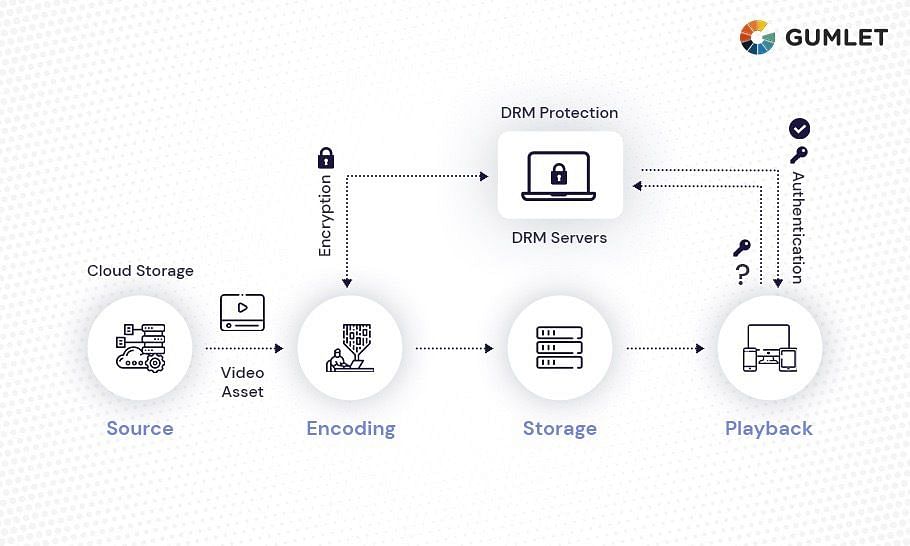
Protect your videos from Piracy
Learn how to protect your videos from piracy and theft with DRM. Talk to our DRM expert to know more.
Popular Video DRM Systems/Technologies
In today's digital landscape, several robust DRM systems exist, each with its strengths and weaknesses. Let's dive into the most popular ones:
Widevine DRM (Google)
Widevine is arguably the most widely used DRM solution, boasting extensive compatibility across platforms and devices. It's integrated into major browsers like Chrome and Firefox, Android devices, and Chromecast, reaching a vast audience. Widevine offers multiple security levels, from software-based encryption to secure hardware execution environments, making it adaptable to various content protection needs.
FairPlay DRM (Apple)
Apple's FairPlay DRM reigns supreme within the Apple ecosystem, protecting content on iTunes, Apple TV, and iOS devices. Its tight integration and security features make it a go-to for safeguarding high-value content like Hollywood movies. However, its limited platform compatibility excludes non-Apple devices, restricting its reach.
PlayReady DRM (Microsoft)
Developed by Microsoft, PlayReady is another prominent DRM choice. It comes pre-installed on Windows devices and integrates seamlessly with the Microsoft ecosystem, including Xbox and Windows Phone. PlayReady shines in offline playback capabilities, allowing downloaded content to be viewed without an internet connection. However, its platform reach is narrower compared to Widevine.
Other DRM Options
Beyond these giants, several other DRM systems cater to specific needs and niches:
- DRMPrime: Developed by THEOplayer, DRMPrime focuses on flexibility and hybrid deployments, adapting to various platforms and content delivery networks.
- Marlin: An open-source DRM solution, Marlin offers low licensing costs and transparency, but its adoption outside niche applications is limited.
The best DRM system for you depends on various factors, including:
- Target platforms and devices: Consider where your viewers will access your content and choose a system with compatible playback options.
- Security requirements: High-value content might demand a more robust DRM solution like FairPlay, while simpler content might work with a system like Widevine.
- Budget and licensing: Compare costs and licensing models of different DRM providers to find the best fit for your needs.
Remember, DRM systems are valuable tools for protecting your video content, but they should not hinder user experience. Choose a solution that balances security with accessibility and consider additional security measures like watermarking and access control mechanisms for comprehensive content protection.
Top 5 Video Hosting DRM Providers for your Videos
There is a host of DRM Solutions available to content producers today, including the widely used systems like Google's Widevine and Apple's Fairplay.
Let's look at the top Video Hosting DRM Providers you can consider for your videos:
Gumlet
Gumlet is a cutting-edge DRM protection solution that helps content producers protect their video streams with top-grade encryption setups like Apple Fairplay DRM and Google's Widevine DRM. Given its support for both iOS and Android operating systems, Gumlet is a powerful digital rights management software that guarantees universal playback of content across the majority of browsers while ensuring top-level security and user experience.
Brightcove
Brightcove is another solution that aims to deliver DRM-protected content to a broad range of platforms and browsers. Some of these include MPEG-DASH (using CENC DRMs) and HLS (using FairPlay).
JW Player
JW Player allows distributors to prioritize engaging content experiences while their water-tight DRM policies ensure industry-standard protection of their digital content. It is a quick and easy-to-use software that relies on DRM media content key generation and licensing systems to ensure seamless content playback on different devices.
Bitmovin
Bitmovin is an intelligent DRM solution provider that is compatible with a wide range of browsers. The Bitmovin Adaptive Streaming HTML5 Player allows content distributors to easily configure and apply DRM solutions to encode their content for high-level security and low-level latency.
VdoCipher
VdoCipher is touted to be a "Hollywood Grade" DRM solution that provides end-to-end protection to your copyrighted material. It is a quick & intuitive multi-DRM protection scheme that restricts hackers from accessing your content and prevents piracy.
With multiple DRM video encryption setups, support for Widevine and FairPlay streaming, backend licensing, and more—VdoCipher is one of the most effective DRM for Android and iOS video platforms.
Functionalities and Limitations of Video DRM
Video DRM, Digital Rights Management, acts as a digital moat for your precious video content. But like any defensive measure, it has its strengths and weaknesses. Let's explore what DRM does and where it reaches its limits.
Functionalities:
- Piracy Prevention and Revenue Protection: Imagine your video as a rare jewel. DRM scrambles it, making unauthorized access akin to snatching through a vault door. This deters casual copying and protects your financial return.
- Content Control and Security for Rights Holders: Think of a personalized key for each viewer. DRM systems grant access only to authorized users and devices, safeguarding your content from unauthorized distribution and ensuring rights holders retain control.
- Flexibility in License Agreements and Distribution: Offering early access or tiered content? DRM enables flexible license models, allowing you to cater to different audiences and maximize your content's reach.
Limitations:
- User Experience Trade-off: Security sometimes comes at a cost. While seamless solutions exist, some DRM implementations can add complexity, requiring logins or specific player software, potentially hindering smooth user experience.
- Piracy Isn't Eradicated: Think of a determined wall climber. No DRM system is foolproof. While it deterrents casual copying, dedicated hackers might find ways to circumvent it, especially for older or weaker implementations.
- Device and Platform Compatibility Issues: Not all keys fit every lock. Some DRM systems might not work on certain devices or platforms, limiting your audience reach if not chosen strategically.
DRM Compatibility with Browsers, Video Players, Devices
Here's a breakdown of DRM compatibility of popular Video DRM systems across browsers, video players, and devices:
| DRM System | Browsers | Video Players | Devices |
|---|---|---|---|
| Widevine DRM | Chrome, Firefox | VLC, JW Player, THEOplayer | Android, Chromebooks, Chromecast |
| PlayReady DRM | Edge | Windows Media Player, JW Player | Windows PCs, Xbox, Windows Phone |
| FairPlay DRM | Safari | QuickTime Player | Apple devices (Mac, iPhone, iPad, Apple TV) |
Important Notes:
Factors like regional variations, licensing agreements, and specific player configurations can further influence access. To ensure seamless playback for your viewers, consider these tips
- Widevine offers the broadest reach, while PlayReady and FairPlay cater to specific ecosystems.
- Compatibility constantly evolves, so check for updates from DRM providers and platform developers.
- Some platforms, like smart TVs, have built-in DRM support for specific systems.
- Older devices or software might not support newer DRM versions. Consider your target audience and their preferred platforms when choosing a DRM system.
By understanding DRM compatibility and making informed choices, you can unlock your video content's full potential and reach viewers wherever they choose to watch.
Conclusion
DRM is becoming a mandatory practice for major video streaming platforms to protect copyrighted content transmission. Reliable DRM solutions control user access, prevent unauthorized content distribution, and protect copyright holder rights. For effective DRM applications, prioritize solutions that combine licensing and encryption technologies. Gumlet supports Widevine DRM and Fairplay DRM, ensuring universal playback across devices and platforms.
FAQs
1. What is DRM licensing?
DRM licensing is a type of content protection used to control the use of digital content and devices after sale.
2. What are the benefits of DRM?
DRM's benefits are: Protection of Intellectual property, Piracy Prevention, Improved Control over digital content and Increased Revenue.
3. What is an example of DRM?
Apple's FairPlay is an example of DRM, which protects music, movies, and other content purchased from the iTunes Store.
4. How is DRM implemented?
DRM is implemented by encrypting the content with a unique key and restricting access to it with a license. This license is stored on the user's device and limits the user's access to the content. The content is then decrypted with the key and can only be accessed with the correct license. This ensures that the content is only available to those with the correct license.

